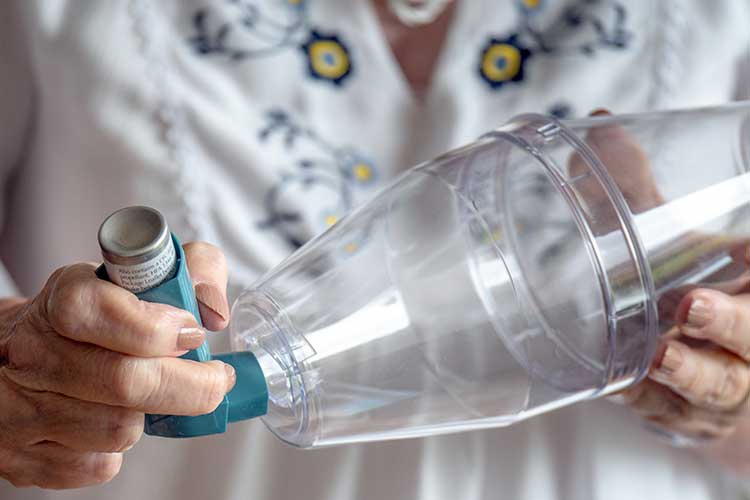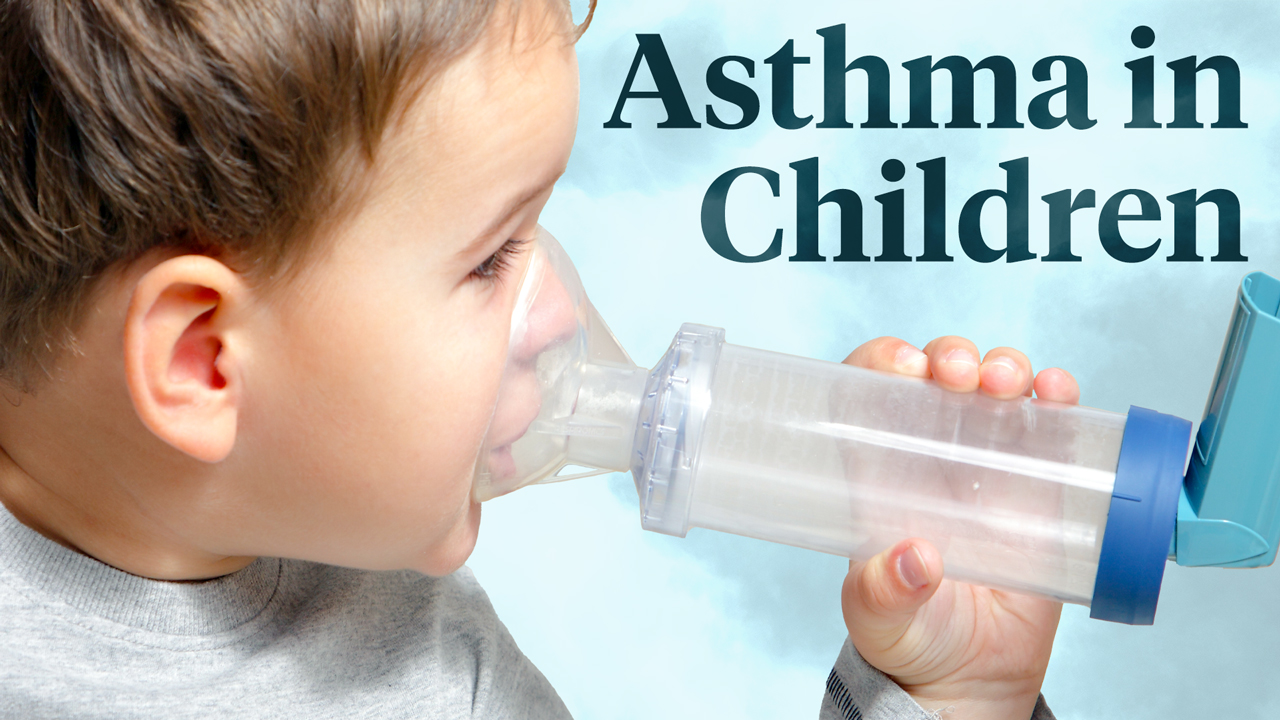In Australia, asthma affects about 10% of people aged 0-14, making it the most common chronic illness experienced by children (AIHW 2022).
Signs and Symptoms of Asthma in Children
When identifying asthma in children, you might notice signs of respiratory distress. The child may have a costal/intercostal recession or tracheal tug. Nasal flaring or head bobbing in younger children may also be apparent (PCH 2022).
Upon auscultation of the chest, reduced air entry and/or wheezing may be heard. A child may be unable to speak in sentences or even may be short of breath after walking a short distance (SA Health 2021).
Beware of a silent chest. If there is no audible wheeze and no obvious breath sounds, this could mean the child is having a severe asthma attack. This is a life-threatening situation (SA Health 2021).
The patient’s history is important when assessing asthma. Is there any family history of atopy? Does the child usually need an inhaler and if so, when did they last need it? Any previous ICU admissions? Any viral prodrome? (SA Health 2021).
On presentation to the emergency department, many children may have already seen a GP or commenced treatment at home. Assessing the child in regards to previous recent treatment is also useful to assess treatment efficacy. A child who has had back-to-back salbutamol at the GP’s surgery may need more than just six puffs of their inhaler.
Although the diagnosis of asthma in younger children is sometimes difficult, the National Asthma Council has developed the below table to aid clinicians in decision-making for children aged one to five years.
Note: The RCH Melbourne’s Asthma Guidelines also advise to consider bronchiolitis as an alternative in children under 12 months - in these children, salbutamol will provide little therapeutic relief (RCHM 2020).
| Asthma more likely | Asthma less likely |
More than one of:
|
Any of:
|
| AND | |
Any of:
|
(Adapted from National Asthma Council 2022)
Treatment of Children with Asthma
Once asthma has been diagnosed, the initial treatment is usually an inhaled bronchodilator (beta-agonist). Salbutamol is most commonly used. Oxygen should only be used for hypoxia (saturations of less than 90%), not for work of breathing or wheeze (RCHM 2020).
Spacers are just as effective as nebulisers and should be used for children of all ages. Practically, a small volume spacer can be used for children of all ages and with good effect (National Asthma Council 2018; RCHM 2020).
As a general rule, children younger than six should receive six puffs of salbutamol (100 mcg/puff) via a metered dose inhaler (MDI). Children over six require 12 puffs. Initially, in an acute presentation, salbutamol is given as a ‘burst’ - that is, one dose every 20 minutes for one hour (i.e. three doses), then reviewed and given as needed (RCHM 2020).
Some clinicians also choose to give inhaled ipratropium bromide (atrovent) as an initial treatment (SA Health 2021).
Prednisolone is also given orally in acute asthma exacerbations. The current Royal Children’s Hospital guidelines (2020) advise 2 mg per kg as an initial dose and then 1 mg per kg per dose per day for one to two more days.
Caution is advised when considering giving steroids to pre-schoolers. The new advice is to give only if the child will be admitted to a children’s ward or intensive care unit with a wheeze that responds to bronchodilators in this age range (RCHM 2020).
For children who are sicker and are slower to respond to inhaled therapy, intravaneous medications should be considered.
IV magnesium sulphate is considered a good option for the management of acutely unwell children. It is a smooth muscle relaxant, although its exact mechanism is unclear. Hospital policies vary but if more than two doses of magnesium are given, this is often an indication that admission to a hospital with high dependency unit or ICU facilities is required. The child will at the very least need to be admitted under the care of a paediatrician. IV salbutamol is also an option and once again is likely to lead to admission (RCHM 2020).

Long-Term Treatment of Children with Asthma
Preventative options for children with frequent episodic asthma should be considered. Montelukast (singlair) or a low dose inhaled corticosteroid such as flixitide can be used as first line preventers. Children requiring a preventer should be taken to a GP regularly to help manage their asthma and monitor symptoms and exacerbations (RCHM 2020).
All patients with asthma, whether visiting a GP’s surgery or an emergency department, should receive a written asthma management plan. There is good evidence that written plans aid education and improve compliance (RCHM 2020).
A safety net for both families and clinicians is good discharge advice, especially advice about when to return to hospital or seek a GP review. If a child needs salbutamol more frequently than every three hours, a review should be sought (SA DoH 2021).
Notes
This advice is general in nature and local hospital clinical guidelines should be followed. A good resource for those seeking further information is The Royal Children’s Hospital Melbourne Clinical Practice Guidelines. This site also provides excellent parental handouts.
This article is the second in a series of articles about paediatric respiratory conditions and, ideally, should be read in conjunction with Paediatric Respiratory Assessment.
Note: This article is intended as a refresher and should not replace best-practice care. Always refer to your facility's policy on treating paediatric asthma.
Test Your Knowledge
Question 1 of 3
True or false: A silent chest could indicate a life-threatening situation.
Topics
References
- Australian Institute of Health and Welfare 2022, Australia's Children: Chronic Conditions and Burden of Disease, Australian Government, viewed 2 June 2023, https://www.aihw.gov.au/reports/children-youth/australias-children/contents/health/chronic-conditions-and-burden-of-disease
- Cates, CJ, Welsh, EJ & Rowe, BH 2014, ‘Holding Chambers (Spacers) Versus Nebulisers for Beta-agonist Treatment of Acute Asthma (Review)’, Cochrane Database of Systematic Reviews, viewed 5 June 2020, https://www.cochranelibrary.com/cdsr/doi/10.1002/14651858.CD000052.pub3/pdf/CDSR/CD000052/CD000052_abstract.pdf
- National Asthma Council 2022, Australian Asthma Handbook, National Asthma Council, viewed 5 June 2023, https://www.asthmahandbook.org.au/
- National Asthma Council 2018, Spacer Use and Care, National Asthma Council, viewed 5 June 2023, https://www.nationalasthma.org.au/living-with-asthma/resources/patients-carers/factsheets/spacer-use-and-care
- Perth Children’s Hospital 2022, Serious Illness, Government of Western Australia, viewed 2 June 2023, https://pch.health.wa.gov.au/For-health-professionals/Emergency-Department-Guidelines/Serious-illness
- Royal Children’s Hospital Melbourne 2018, Asthma Acute, Royal Children’s Hospital Melbourne, viewed 5 June 2020, https://www.rch.org.au/clinicalguide/guideline_index/Asthma_acute/
- SA Health 2021, South Australian Paediatric Clinical Practice Guidelines: Acute Asthma in Children, Government of South Australia, viewed 2 June 2023, https://www.sahealth.sa.gov.au/wps/wcm/connect/8169868040d035a79695be40b897efc8/Acute+Asthma+in+Children_Paed_v3_1.pdf?MOD=AJPERES&CACHEID=ROOTWORKSPACE-8169868040d035a79695be40b897efc8-n8V9hUY
- World Health Organisation 2020, Asthma, World Health Organisation, viewed 5 June 2020, https://www.who.int/news-room/fact-sheets/detail/asthma
Additional Resources
- Australian Asthma Handbook
- Clinical Practice Guidelines: Acute Asthma | Royal Children’s Hospital Melbourne
- Asthma: How Does it Affect the Body? | Ausmed Article
- A Basic Guide to Chest Auscultation | Ausmed Article
- Important Lung Sounds Made Easy: A Practical Guide (With Full Audio) | Ausmed Article
- Paediatric Respiratory Assessment | Ausmed Article

